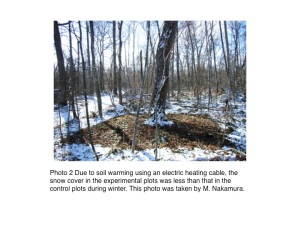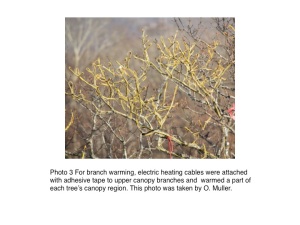Updated: 23/04/2025
Experimental warming is an effective approach to determine the effect of increasing temperature on ecological processes, with few confounding factors (e.g., other variables that covary spatially and temporally with temperature). Therefore, a number of field experiments have been initiated worldwide to study the effects of simulated global warming. A wide range of techniques (e.g., greenhouses, open-top chambers, and electric infrared heaters) have been developed to experimentally warm a variety of small plants, including those of the tundra, grasslands, and sapling trees. Within forests, most insect species diversity and plant-insect interactions are concentrated in the canopy of mature trees, rather than in the understory, because of higher plant productivity. However, few studies have examined the responses of mature trees to experimental warming in natural forests.
In the paper “Different initial responses of the canopy herbivory rate in mature oak trees to experimental soil and branch warming in a soil-freezing area”, we report the initial 3-year (2007–2009) results of an experimental warming of mature Quercus crispula (18–20 m in height), a late-successional tree species. Five mature Q. crispula trees whose canopy was accessible by a gondola hanging from a construction crane were selected (Photo1). To better understand the mechanism by which global warming affects plant-insect interactions in the canopy of mature oak trees, field experiments must warm aboveground and belowground regions separately. Thus, we experimentally increased the temperature of the surrounding soil and canopy branches of mature oak trees by approximately 5°C using electric heating cables (Photo 2 and 3).
Our warming experiment clearly demonstrates that plant-insect interactions in the canopy responded differently to soil and branch warming of mature oak trees. Soil warming in a mature cool-temperate forest with a freeze-thaw cycle decreased the nutritional quality of leaves and the rate of herbivory in the canopy, whereas branch warming had no effect on canopy leaf traits or the herbivory rate. The magnitude of the indirect (plant-mediated) effects of belowground temperature elevation on canopy herbivory was gradually enhanced during the initial 3 years of the study. These results suggest that belowground temperature elevation due to global warming in a soil freezing area is an important driving force of plant-insect interactions in the canopy. For a better understanding of the mechanism by which global warming affects plant-insect interactions in mature cool-temperate forests, this warming experiment should be continued using mature oak trees because indirect effects of temperature are likely more pronounced in the long- than in the short-term.
Masahiro Nakamura and co-workers



